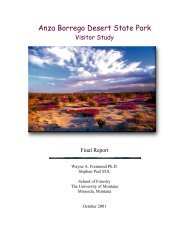Final Mitigated Negative Declaration and Response to Comments
Final Mitigated Negative Declaration and Response to Comments
Final Mitigated Negative Declaration and Response to Comments
Create successful ePaper yourself
Turn your PDF publications into a flip-book with our unique Google optimized e-Paper software.
IX.<br />
HYDROLOGY AND WATER QUALITY.<br />
ENVIRONMENTAL SETTING<br />
The climate of the Lake Tahoe region is generally Mediterranean, but is modified by<br />
<strong>to</strong>pography <strong>and</strong> geography. It is characterized by relatively warm, dry summers interrupted by<br />
occasional lightning s<strong>to</strong>rms, <strong>and</strong> cold wet winters with variable precipitation mostly falling as<br />
snow. About 95% of the precipitation falls between Oc<strong>to</strong>ber <strong>and</strong> May. An average of more<br />
than 80 inches of precipitation falls on the west side of the Lake Tahoe Basin, mostly as snow<br />
(Bough<strong>to</strong>n et al. 1997). The annual mean temperature is 45 degrees. The coldest month is<br />
February, with an average temperature of 28 degrees. Average summer temperatures range<br />
from 60 <strong>to</strong> 80 degrees during the day, <strong>and</strong> from 35 <strong>to</strong> 40 degrees at night. Snow accounts for<br />
75% <strong>to</strong> 80% of the <strong>to</strong>tal precipitation, with an average snowfall of 200 <strong>to</strong> 325 inches. The<br />
normal average precipitation in the basin is 34 inches.<br />
Infrequent large, warm winter s<strong>to</strong>rms can potentially produce extreme streamflows <strong>and</strong> flooding<br />
resulting from high rainfall <strong>and</strong> melting of existing snowpack. The seasonal snowmelt process<br />
results in peak streamflows between May <strong>and</strong> June. Minimum streamflows occur during late<br />
summer <strong>and</strong> fall.<br />
Lake Tahoe is recognized as an Outst<strong>and</strong>ing National Resource Water by the U.S.<br />
Environmental Protection Agency’s Water Quality St<strong>and</strong>ards Program <strong>and</strong> the Clean Water<br />
Act. Under this designation, Lake Tahoe is afforded the highest protection from degradation<br />
(TRPA 2002). The Water Quality Control Plan for the Lahontan Region (LRWQCB 1994<br />
Chapter 5: Water Quality St<strong>and</strong>ards <strong>and</strong> Control Measures for the Lake Tahoe Basin) has<br />
designated beneficial uses for the surface waters of the Lake Tahoe Hydrologic Unit, such as<br />
Cold Freshwater Habitat. The Cold Freshwater Habitat (COLD) definition is “beneficial uses of<br />
waters that support cold water ecosystems including, but not limited <strong>to</strong>, preservation <strong>and</strong><br />
enhancement of aquatic habitats, vegetation, fish, <strong>and</strong> wildlife…” For all waters designated<br />
COLD, the temperature shall not be altered. Other Beneficial Uses such as municipal water<br />
supply <strong>and</strong> recreational uses are discussed under other sections of this document.<br />
Lake Tahoe is considered <strong>to</strong> be an oligotrophic lake, with low concentrations of nutrients, low<br />
algal productivity, <strong>and</strong> high oxygen content. These fac<strong>to</strong>rs lead <strong>to</strong> its exceptional clarity. There<br />
has been a significant decline in water clarity since 1968 (UC Davis 2010). Current concerns<br />
are attributed in part <strong>to</strong> the increased algal growth caused by nutrient inputs from development<br />
of the Lake Tahoe watershed. Control of nutrient inputs <strong>to</strong> the lake has thus become one of<br />
the priorities of regula<strong>to</strong>ry agency action in the basin.<br />
Asian Clam Control Project IS/MND<br />
Emerald Bay State Park<br />
California Department of Parks <strong>and</strong> Recreation<br />
52
















